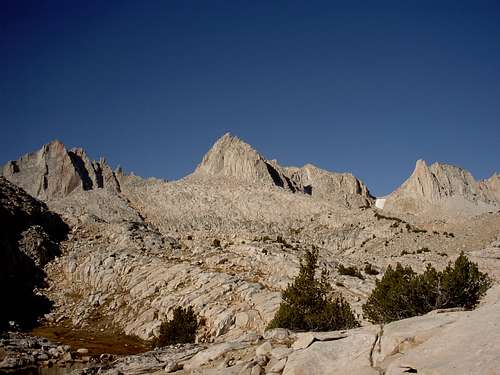The pilots f$#ked up and tried to cover it up. If they had mechanical problems, why didn't they report it?
An air tanker working for the U.S. Forest Service last summer dropped a load of fire retardant across the summit of a pristine High Sierra peak, leaving a bright red stripe that is visible for miles.
Investigators still are trying to determine what took place July 8 in the skies above 13,200-foot Feather Peak, about 15 miles northeast of Florence Lake in California's John Muir Wilderness. No fire was burning nearby.
The incident went unreported until wilderness rangers from the Inyo National Forest began fielding questions from hikers and climbers about the large, red stain across an otherwise white granite mountaintop.
"It's a mess -- the stain is very obvious," said Robert "SP" Parker, who co-owns Sierra Mountain Center, a guiding service in Bishop, Calif. "It definitely detracts from the mountain's wilderness character."
Dennis Brown, aviation safety manager for the Forest Service's Pacific Southwest Region, said retardant is commonly jettisoned if not used on fires because tankers cannot land while loaded. However, pilots are instructed not to dump their loads in sensitive areas except in an emergency. Most airfields have designated areas for retardant drops, either nearby or on private property.
But crewmembers said it was, in fact, an emergency that caused them to drop 1,800 gallons of retardant on Feather Peak -- a claim that officials have come to doubt.
Brown said he wasn't informed about the drop until a month after it occurred. He then interviewed the plane's two crewmembers, employees of Nevada-based Minden Air Corp., who told him the Lockheed P2V developed engine trouble while trying to cross the Sierra Nevada during daylight hours. They dropped the 17,500-pound load of retardant to avert a potential crash.
The pilot and co-pilot were unaware they were flying above a wilderness area and regretted their choice of dumping ground, Brown said.
"I was told the plane developed engine trouble and they had to jettison the load, which is the proper thing to do in that situation," Brown said. "Since then, we've found out maybe that wasn't an accurate story."
Brown wouldn't go into detail about his findings. But enough questions remain that the Office of General Counsel referred the matter to the Forest Service's Law Enforcement & Investigations branch in Washington, D.C., Sierra National Forest spokeswoman Sue Exline said.
"It's an ongoing investigation," Exline said. "I can't say anything more."
Leonard Parker, the CEO of Minden Air Corp., a private contractor that assists the Forest Service in fire prevention, declined to name the crew members or make them available for interviews.
"(The stain) is there for everyone to see, and no one is denying it happened," Parker said. "Other than that, I'd rather not comment."
Experts say the red stripe across Feather Peak won't fade for several years because the retardant, sold as Phos-Chek D-75R, contains iron oxide. The bright color helps pilots ensure they've hit their targets.
Rich Fairbanks, a fire management expert for the Wilderness Society, called the stain "unfortunate, but not permanent."
"That stuff in a body of water is an environmental nasty," Fairbanks added. "On the side of the peak, it's an aesthetic issue."
Because the drop occurred on a rocky mountaintop high above the tree line and not near a water source, it is not being treated as an environmental hazard. The retardant, which has the consistency of heavy liquid, contains mostly phosphates similar to those found in fertilizer. It is not toxic to humans, Brown said.
Officials are confident that snow and rain common to the area in winter and spring will help the fading process.
"It happened, and there's not much we can do about it," said Rob Mason, wilderness manager of the High Sierra Ranger District. "We're not going to send crews out there to scrub rocks."
Although Feather Peak lies in the Sierra National Forest, it is more accessible through the Inyo National Forest on the range's eastern side.
According to Forest Service officials, Tanker 55 launched from the Porterville Air Base headed to Cedar City, Utah, when a call came in from the Fresno-Kings Unit that diverted the plane north.
While flying over the Sierra National Forest, the call from Fresno-Kings was canceled, so Tanker 55 resumed an easterly heading. It was then, crewmembers said, that the plane developed engine trouble while approaching Pine Creek Pass.
"They had to get rid of the load somewhere," Brown said. "In hindsight, they certainly picked the worst possible spot."
After the drop, the engine trouble seemed to correct itself and the plane landed safely at the Cedar City Air Base. The pilots did not report any mechanical issues.
The pilot purposefully flew close to the ground so that the retardant would be spread over as small an area as possible, Brown said. He added that both crewmembers were remorseful about the result.
"I didn't find any evidence that he purposefully marked that peak," Brown said. "I didn't feel it was malicious. ... But it looks now that maybe (the pilot) didn't have an emergency situation that would've forced him to drop the retardant."
Stains from retardant drops can remain visible for years.
Though remote, Feather Peak is frequently climbed in the summer and early fall. Hikers who passed through the area in August left with red stains on their hands and clothes.
In an e-mail, Leor Pantilat, a Stanford University law student who photographed the stain from nearby Royce Peak, said it spoiled his experience in the mountains.
"It takes away from the wilderness feeling to find such large evidence of human impact," Pantilat wrote.


